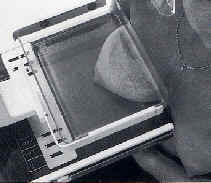- Q: Do all women have enough breast tissue to have a mammogram?
- Q: Will portions of breast tissue not be imaged on women with small breasts because the tissue does not protrude very much?
- Q: Is mammography less accurate on women with small breasts?
- Q: Is a mammogram more painful for women with small breasts?
- Q: Are small-breasted women less likely to get breast cancer because they have less breast tissue?
- Q: What are some alternative breast cancer screening exams for women with small breasts?
- Additional Resources and References
A: A mammogram requires that the breasts be compressed briefly, which may be uncomfortable for some women regardless of breast size. However, mammograms should not be significantly painful. Breast compression is necessary to flatten the breast so that the maximum amount of tissue can be imaged and examined. Patients should feel firm pressure due to compression but no significant pain. Patients who feel pain should inform the technologist so that the breast may be repositioned. Women who have sensitive breasts may wish to schedule their mammograms at times of the month when the breasts are less tender. In general, the week before and during menstruation is when breasts are most tender, and the week after a period is when breasts are the least tender. Click here for more tips for a successful mammogram.

Breast compression is necessary to flatten the breast so that the maximum amount of tissue can be imaged and examined.
A: The amount of breast tissue a woman has does not affect her risk of developing breast cancer. Click here to learn about the risk factors for breast cancer.
A: Currently, mammography is the only screening exam approved by the FDA to help screen for breast cancer in asymptomatic women (women with no signs or symptoms of the disease). All women 40 years of age should have a screening mammogram every one or two years. Women 50 years of age and older should receive screening mammograms every year. Mammography has been shown to detect 85% to 90% of breast cancers. If a mammogram reveals a breast abnormality, the concern may then be further assessed with other imaging tests (such as ultrasound) or a biopsy may be performed. In addition, if a mammogram does not reveal any breast abnormalities but the patient’s physician is still concerned, further imaging tests may be ordered.
- To learn more about mammography, please visit http://www.imaginis.com/breasthealth/mammography.asp
- To learn more about guidelines for early breast cancer detection, please visit http://www.imaginis.com/breasthealth/earlydetection.asp
Updated: November 28, 2009



